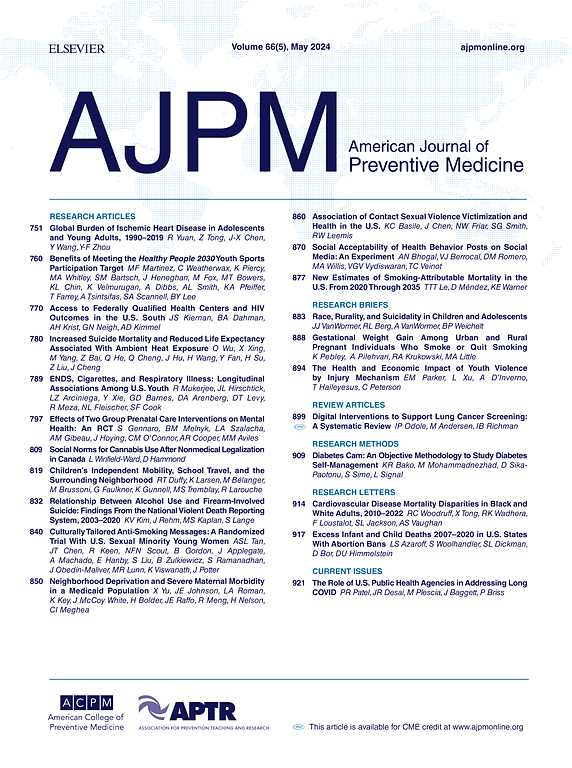Trends in Prenatal Opioid Use Disorder in California, 2010–2022
IF 4.5
2区 医学
Q1 MEDICINE, GENERAL & INTERNAL
引用次数: 0
Abstract
Introduction
Opioid-related deaths among perinatal populations have increased sharply in the U.S. Whether the recent ascendance of illicit fentanyl and other synthetic opioids in the drug supply translates to an increase in prenatal opioid use disorder remains unknown. This study investigated whether California’s comparatively late fentanyl influx, in 2019, was associated with a subsequent increase in opioid use disorder among pregnant people.
Methods
This ecologic, repeated retrospective cohort study examined annual cohorts of individuals with an index live-birth delivery in California from 2010 to 2022. Analyses used statewide, all-payer linked hospitalization and emergency department records. Overall and subgroup-specific trends in the prevalence of prenatal opioid use disorder, assessed using International Classification of Diseases, Ninth Revision, Clinical Modification/ICD-10-CM diagnoses recorded at delivery hospitalization and during prenatal emergency department visits, were examined using joinpoint and logistic regression analyses. Data analysis was conducted in 2025.
Results
The study included 4,381,064 index deliveries. Between 2010 and 2022, the prevalence of prenatal opioid use disorder doubled (as assessed at delivery: 0.15%–0.30%; as assessed via prenatal opioid use disorder emergency department visits: 0.04%–0.08%). Joinpoint analysis indicated that most of this increase occurred before 2018, with annual percentage changes after 2018 being largely flat (annual percentage change in at-delivery prevalence, 2.4% [95% CI= −2.2%, 7.3%]; annual percentage change in emergency department visit prevalence, 1.4% [95% CI= −7.0%, 3.8%]). Differences in the 2019–2022 versus 2010–2018 prevalence of prenatal opioid use disorder were larger among non-Hispanic White and other/multiple race individuals, as well as those covered by Medicaid.
Conclusions
The recent introduction of fentanyl to California was associated with only incremental increases in the prevalence of prenatal opioid use disorder. Continued tracking of these trends is important for perinatal health.
2010-2022年加州产前阿片类药物使用障碍趋势
导言:在美国,围产期人群中阿片类药物相关死亡急剧增加。最近非法芬太尼和其他合成阿片类药物在药物供应中的上升是否转化为产前阿片类药物使用障碍(OUD)的增加仍然未知。这项研究测试了2019年加州相对较晚的芬太尼流入是否与随后孕妇中OUD的增加有关。方法:这项生态的、重复的回顾性队列研究检查了2010-2022年加州每年有活产分娩指数的个体队列。分析使用了全州范围内与所有付款人相关的住院和急诊科(ED)记录。使用ICD-9/10-CM诊断评估分娩住院和产前ED就诊时产前OUD患病率的总体和亚组特定趋势,并使用联结点和逻辑回归分析进行检查。数据分析于2025年进行。结果:本研究共纳入4381064例指标交付。2010年至2022年期间,产前OUD患病率翻了一番(分娩时评估:0.15%至0.30%;产前OUD ED检查评估:0.04%至0.08%)。Joinpoint分析表明,这一增长大部分发生在2018年之前;2018年之后的年度百分比变化(APC)基本持平(分娩时患病率APC: 2.4%, 95% CI, -2.2%至7.3%;ED患病率APC: 1.4%, 95% CI, -7.0%至3.8%)。2019-2022年与2010-2018年产前OUD患病率的差异在非西班牙裔白人和其他/多种族个体以及医疗补助覆盖的人群中更大。结论:最近在加州引入芬太尼仅与产前OUD患病率的增量增加有关。继续跟踪这些趋势对围产期健康很重要。
本文章由计算机程序翻译,如有差异,请以英文原文为准。
求助全文
约1分钟内获得全文
求助全文
来源期刊

American Journal of Preventive Medicine
医学-公共卫生、环境卫生与职业卫生
CiteScore
8.60
自引率
1.80%
发文量
395
审稿时长
32 days
期刊介绍:
The American Journal of Preventive Medicine is the official journal of the American College of Preventive Medicine and the Association for Prevention Teaching and Research. It publishes articles in the areas of prevention research, teaching, practice and policy. Original research is published on interventions aimed at the prevention of chronic and acute disease and the promotion of individual and community health.
Of particular emphasis are papers that address the primary and secondary prevention of important clinical, behavioral and public health issues such as injury and violence, infectious disease, women''s health, smoking, sedentary behaviors and physical activity, nutrition, diabetes, obesity, and substance use disorders. Papers also address educational initiatives aimed at improving the ability of health professionals to provide effective clinical prevention and public health services. Papers on health services research pertinent to prevention and public health are also published. The journal also publishes official policy statements from the two co-sponsoring organizations, review articles, media reviews, and editorials. Finally, the journal periodically publishes supplements and special theme issues devoted to areas of current interest to the prevention community.
 求助内容:
求助内容: 应助结果提醒方式:
应助结果提醒方式:


